Abstract
Regional abnormalities of left ventricular function are frequently determined from superimposed cavity outlines at end-diastole and end-systole. The timing of end-diastole is standardised with respect to the electrocardiogram, but that of end-systole is undefined, and frequently determined by simple inspection. To examine the effect of variation in the timing of the end-systolic frame on apparent regional wall motion, 35 left ventricular angiograms from patients wit ischaemic heart disease were digitised frame by frame, and the timing of aortic valve closure and mitral valve opening superimposed on contour displays. In 15 patients, the pattern in the two frame display with end-systole taken as aortic valve closure was similar to that when it was taken as mitral valve opening. In the remaining 20, however, there were major discrepancies between the two, because of changes in cavity shape during isovolumic relaxation. These shape changes were the result of asynchronous termination of systole in different regions of the ventricle. In addition, there was a significant increase in left ventricular cavity area of 3.9 +/- 1.7 per cent during isovolumic relaxation, corresponding to an increase in calculated volume of 8.1 +/- 4.5 per cent. Estimates of ejection fraction derived from end-systole taken at end-ejection were thus consistently greater than those at mitral valve opening. These differences in the apparent pattern of regional wall motion resulting from lack of definition of end-systole are large compared with those reported after intervention angiography, or surgery. Thus, if two frame methods are to be used, the timing of end-systole must be standardised. We suggest that end-ejection be used. Changes of shape during isovolumic relaxation should be considered separately.
Full text
PDF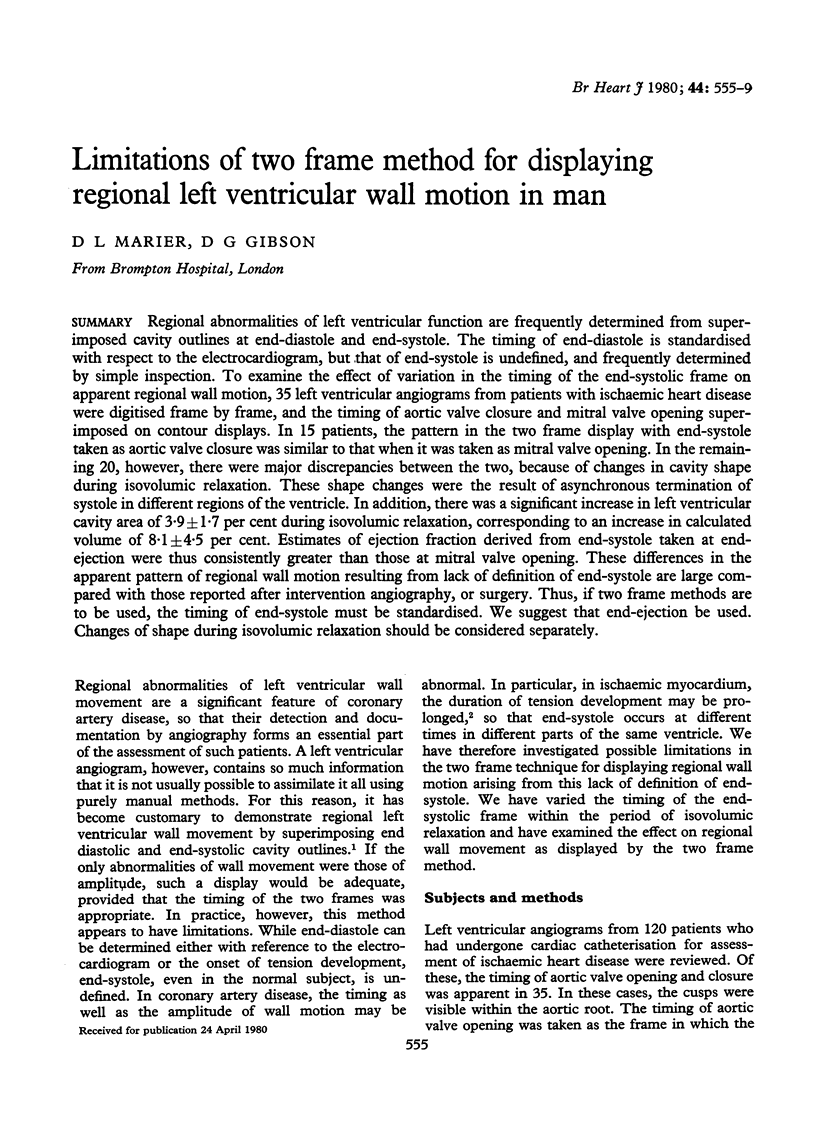
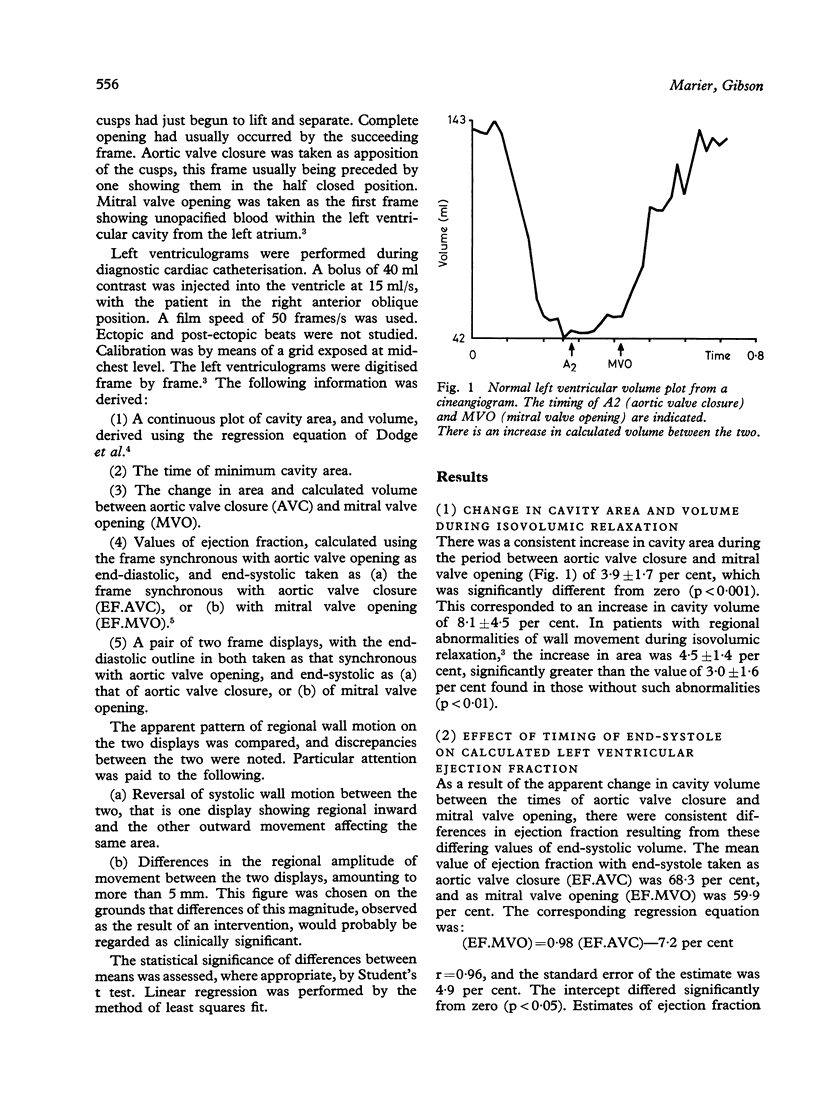
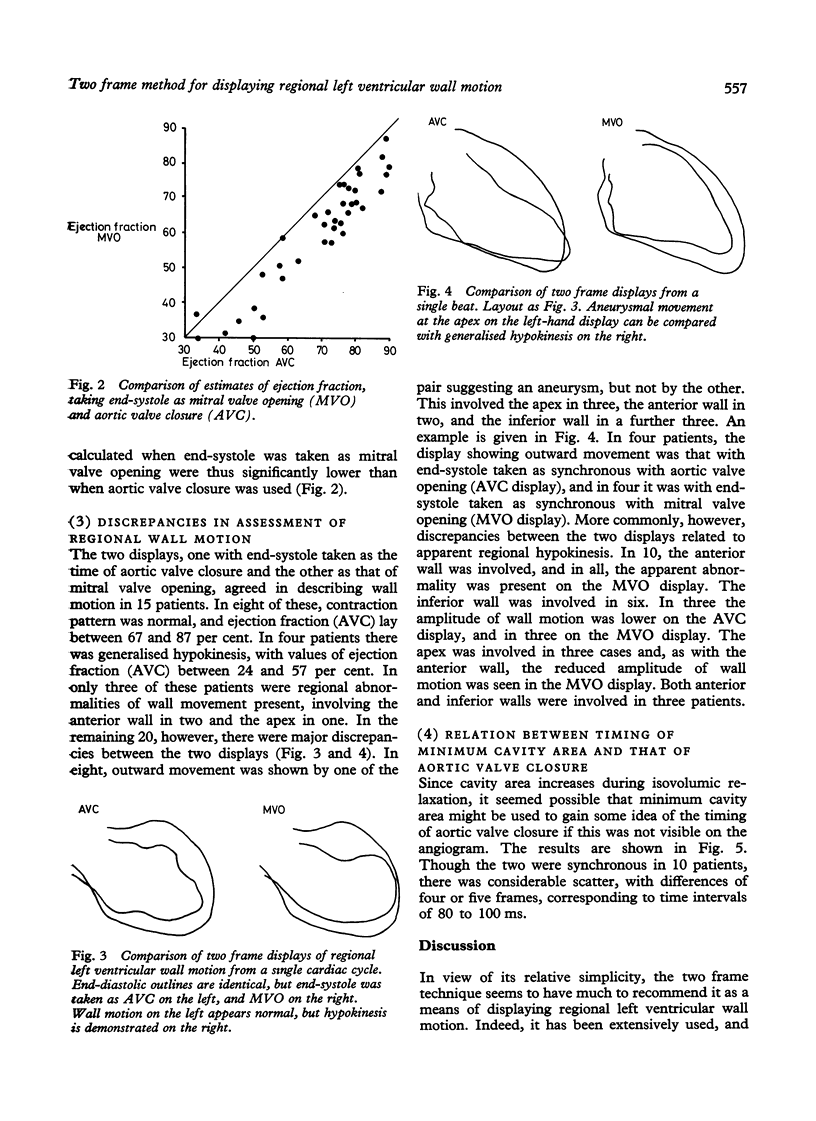
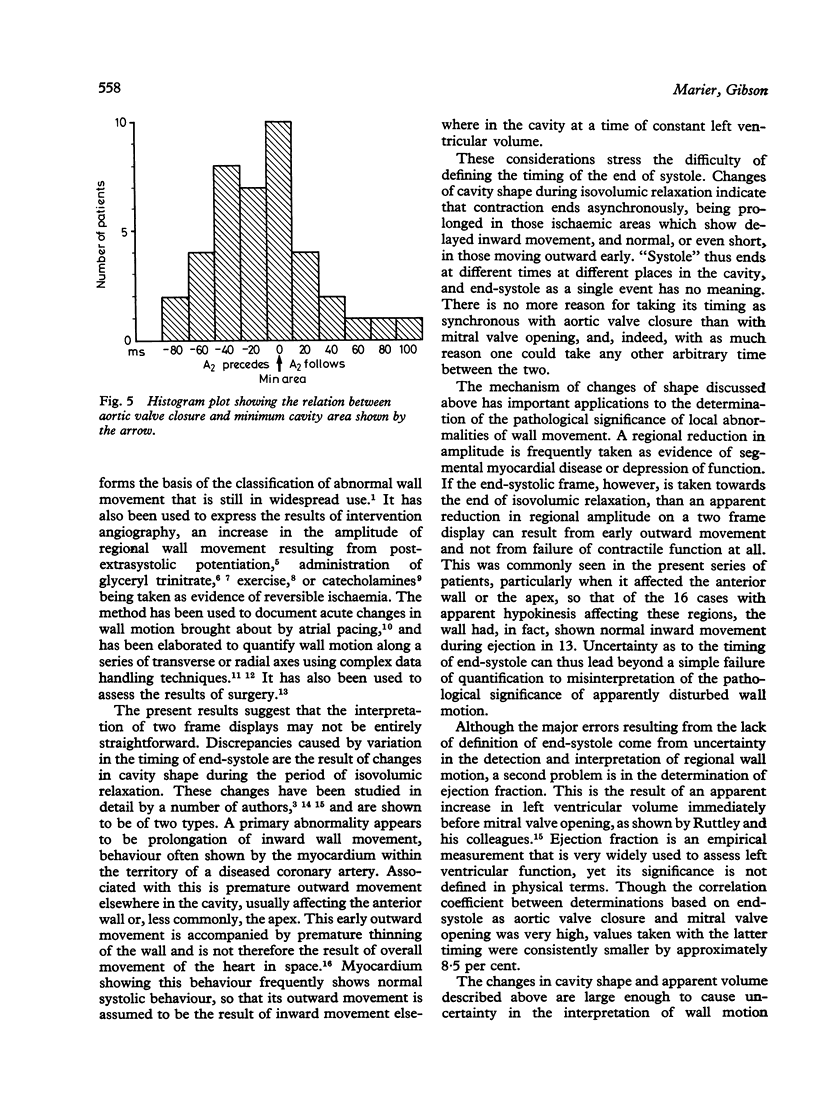
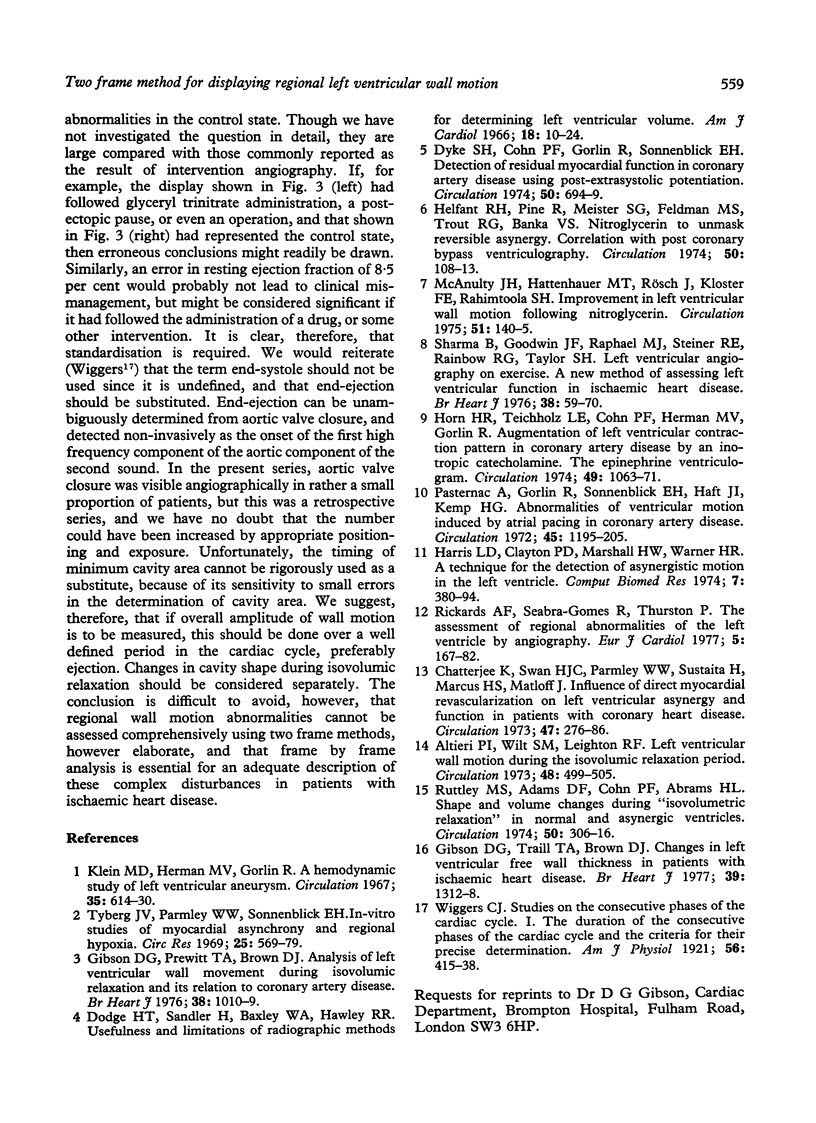
Selected References
These references are in PubMed. This may not be the complete list of references from this article.
- Altieri P. I., Wilt S. M., Leighton R. F. Left ventricular wall motion during the isovolumic relaxation period. Circulation. 1973 Sep;48(3):499–505. doi: 10.1161/01.cir.48.3.499. [DOI] [PubMed] [Google Scholar]
- Chatterjee K., Swan H. J., Parmley W. W., Sustaita H., Marcus H. S., Matloff J. Influence of direct myocardial revascularization on left ventricular asynergy and function in patients with coronary heart disease. With and without previous myocardial infarction. Circulation. 1973 Feb;47(2):276–286. doi: 10.1161/01.cir.47.2.276. [DOI] [PubMed] [Google Scholar]
- Dodge H. T., Sandler H., Baxley W. A., Hawley R. R. Usefulness and limitations of radiographic methods for determining left ventricular volume. Am J Cardiol. 1966 Jul;18(1):10–24. doi: 10.1016/0002-9149(66)90191-3. [DOI] [PubMed] [Google Scholar]
- Dyke S. H., Cohn P. F., Gorlin R., Sonnenblick E. H. Detection of residual myocardial function in coronary artery disease using post-extra systolic potentiation. Circulation. 1974 Oct;50(4):694–699. doi: 10.1161/01.cir.50.4.694. [DOI] [PubMed] [Google Scholar]
- Gibson D. G., Prewitt T. A., Brown D. J. Analysis of left ventricular wall movement during isovolumic relaxation and its relation to coronary artery disease. Br Heart J. 1976 Oct;38(10):1010–1019. doi: 10.1136/hrt.38.10.1010. [DOI] [PMC free article] [PubMed] [Google Scholar]
- Gibson D. G., Traill T. A., Brown D. J. Changes in left ventricular free wall thickness in patients with ischaemic heart disease. Br Heart J. 1977 Dec;39(12):1312–1318. doi: 10.1136/hrt.39.12.1312. [DOI] [PMC free article] [PubMed] [Google Scholar]
- Harris L. D., Clayton P. D., Marshall H. W., Warner H. R. A technique for the detection of asynergistic motion in the left ventricle. Comput Biomed Res. 1974 Aug;7(4):380–394. doi: 10.1016/0010-4809(74)90014-7. [DOI] [PubMed] [Google Scholar]
- Helfant R. H., Pine R., Meister S. G., Feldman M. S., Trout R. G., Banka V. S. Nitroglycerin to unmask reversible asynergy. Correlation with post coronary bypass ventriculography. Circulation. 1974 Jul;50(1):108–113. doi: 10.1161/01.cir.50.1.108. [DOI] [PubMed] [Google Scholar]
- Horn H. R., Teichholz L. E., Cohn P. F., Herman M. V., Gorlin R. Augmentation of left ventricular contraction pattern in coronary artery disease by an inotropic catecholamine. The epinephrine ventriculogram. Circulation. 1974 Jun;49(6):1063–1071. doi: 10.1161/01.cir.49.6.1063. [DOI] [PubMed] [Google Scholar]
- Klein M. D., Herman M. V., Gorlin R. A hemodynamic study of left ventricular aneurysm. Circulation. 1967 Apr;35(4):614–630. doi: 10.1161/01.cir.35.4.614. [DOI] [PubMed] [Google Scholar]
- McAnulty J. H., Hattenhauer M. T., Rösch J., Kloster F. E., Rahimtoola S. H. Improvement in left ventricular wall motion following nitroglycerin. Circulation. 1975 Jan;51(1):140–145. doi: 10.1161/01.cir.51.1.140. [DOI] [PubMed] [Google Scholar]
- Pasternac A., Gorlin R., Sonnenblick E. H., Haft J. I., Kemp H. G. Abnormalities of ventricular motion induced by atrial pacing in coronary artery disease. Circulation. 1972 Jun;45(6):1195–1205. doi: 10.1161/01.cir.45.6.1195. [DOI] [PubMed] [Google Scholar]
- Rickards A., Seabra-Gomes R., Thurston P. The assessment of regional abnormalities of the left ventricle by angiography. Eur J Cardiol. 1977 Mar;5(2):167–182. [PubMed] [Google Scholar]
- Ruttley M. S., Adams D. F., Cohn P. F., Abrams H. L. Shape and volume changes during "isovolumetric relaxation" in normal and asynergic ventricles. Circulation. 1974 Aug;50(2):306–316. doi: 10.1161/01.cir.50.2.306. [DOI] [PubMed] [Google Scholar]
- Sharma B., Goodwin J. F., Raphael M. J., Steiner R. E., Rainbow R. G., Taylor S. H. Left ventricular angiography on exercise. A new method of assessing left ventricular function in ischaemic heart disease. Br Heart J. 1976 Jan;38(1):59–70. doi: 10.1136/hrt.38.1.59. [DOI] [PMC free article] [PubMed] [Google Scholar]
- Tyberg J. V., Parmley W. W., Sonnenblick E. H. In-vitro studies of myocardial asynchrony and regional hypoxia. Circ Res. 1969 Nov;25(5):569–579. doi: 10.1161/01.res.25.5.569. [DOI] [PubMed] [Google Scholar]


